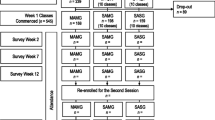Abstract
Background: A growing body of research suggests that older exercisers prefer to exercise alone rather than in group-based settings. One limitation of these studies, however, has been that researchers have failed to take into account the age-related characteristics of groups when asking adults about their preferences for exercise settings.Purpose: The overall purpose of this study was to examine the exercise preferences of 947 adults for involvement in standard exercise classes populated by participants from various categories across the age spectrum.Results: The results revealed that when faced with the prospect of exercising with considerably older or younger exercisers, participants found such an exercise context to be largely unappealing. However, in accordance with the basic tenets of self-categorization theory, the results revealed that older and younger adults alike express a positive preference for exercising in standard exercise classes comprised of similarly aged participants.Conclusions: The findings of this study challenge a growing call for exercise interventions for older adults to be primarily directed at the individual-level, and suggest that group-related intervention strategies may indeed be attractive to older exercisers.
Similar content being viewed by others
References
World Health Organization:Health and Development Through Physical Activity and Sport. Geneva, Switzerland: World Health Organization, 2003.
World Health Organization:The World Health Report 2002: Reducing Risks, Promoting Healthy Life. Geneva, Switzerland: World Health Organization, 2002.
Pate RR, Pratt M, Blair SN, et al.: Physical activity and public health: A recommendation from the center for disease control and prevention and the American college of sports medicine.Journal of the American Medical Association. 1995,273:402–407.
Sallis JF: Epidemiology of physical activity and fitness in children and adolescents.Critical Reviews in Food Science and Nutrition. 1993,33:403–408.
Sallis JF, Patrick K: Physical activity guidelines for adolescents: Consensus statement.Pediatric Exercise Science. 1994,6:302–314.
Sparling PB, Owen N, Lambert EV, Haskell WL: Promoting physical activity: The new imperative for public health.Health Education Research. 2000,15:367–376.
King AC, Castro C, Wilcox S, et al.: Personal and environmental factors associated with physical inactivity among different racial-ethnic groups of U.S. middle-aged and older-aged women.Health Psychology. 2000,19:354–364.
King AC, Taylor CB, Haskell WL, DeBusk RF: Identifying strategies for increasing employee physical activity levels: Findings of the Stanford/Lockheed exercise survey.Health Education Quarterly. 1990,17:269–285.
Wilcox S, King AC, Brassignton GS, Ahn DK: Physical activity preferences of middle-aged and older adults: A community analysis.Journal of Aging and Physical Activity. 1999,7:386–399.
Burke SM, Carron AV, Eys MA: Physical activity context: Preferences of university students.Psychology of Sport and Exercise. 2006,7:1–13.
Thompson CE, Wankel LM: The effects of perceived activity choice upon frequency of exercise behavior.Journal of Applied Social Psychology. 1980,10:436–443.
Daley AJ, Maynard IW: Preferred exercise mode and affective responses in physically active adults.Psychology of Sport and Exercise. 2003,4:347–356.
Castro CM, King AC, Brassington, GS: Telephone versus mail interventions for maintenance of physical activity in older adults.Health Psychology. 2001,6:438–444.
King AC, Friedman R, Marcus B, et al.: Harnessing motivational forces in the promotion of physical activity: The Community Health Advice by Telephone (CHAT) project.Health Education Research. 2002,17:627–636.
Marcus BH, Bock BC, Pinto BM, et al.: Efficacy of an individualized, motivationally-tailored physical activity intervention.Annals of Behavioral Medicine. 1998,20:174–180.
Napolitano MA, Fotheringham M, Tate D, et al.: Evaluation of an internet-based physical intervention: A preliminary investigation.Annals of Behavioral Medicine. 2003,25:92–99.
Jette AM, Lachman M, Giorgetti MM, et al.: Exercise—Its never too late: The strong-for-life program.American Journal of Public Health. 1999,89:66–72.
Deci EL, Ryan RM: A motivational approach to self: Integration in personality. In Dienstbier RA (ed),Nebraska Symposium on Motivation: Perspectives on Motivation (Vol. 38). Lincoln: University of Nebraska Press, 1991, 237–288.
Baumeister RF, Leary MR: The need to belong: Desire for interpersonal attachments as a fundamental human motivation.Psychological Bulletin. 1995,117:497–529.
Carron AV, Burke SM: Context and physical activity: The influence of others.Sport and Exercise Psychology Review. 2005,2:23–31.
Vallerand RJ: A hierarchical model of intrinsic and extrinsic motivation in sport and exercise. In Roberts GC (ed),Advances in Motivation in Sport and Exercise. Champaign, IL: Human Kinetics, 2001, 263–319.
Burke SM, Carron, AV, Eys MA, Ntoumanis N, Estabrooks PA: Group versus individual approach? A meta-analysis of the effectiveness of interventions to promote physical activity.Sport and Exercise Psychology Review. 2006,2:19–35.
Carron AV, Hausenblas HA, Mack DE: Social influence and exercise: A meta-analysis.Journal of Sport and Exercise Psychology. 1996,18:1–16.
Dishman RK, Buckworth J: Increasing physical activity: A quantitative synthesis.Medicine and Science in Sports and Exercise. 1996,28:706–719.
Canadian Fitness and Lifestyle Institute: Patterns of physical activity.Progress in Prevention, Bulletin 2. Ottawa, Canada: Canadian Fitness and Lifestyle Institute, 1996.
Fiske ST, Taylor SE:Social cognition (2nd Ed.). New York: McGraw-Hill, 1991.
Klimoski RJ, Donahue LM: Person perceptions in organizations: An overview of the field. In London M (ed),How People Evaluate Others in Organizations: Person Perception and Interpersonal Judgment in I/O Psychology. Mahway, NJ: Lawrence Erlbaum Associates, 2001, 5–43.
Nickerson RS: How we know—and sometimes misjudge—what others know: Imputing one’s own knowledge to others.Psychological Bulletin. 1999,125:737–759.
United Kingdom Office of National Statistics:United Kingdom 2001 Census. Retrieved September 5, 2006 from http://www.statistics.gov.uk
King AC: Promoting physical activity across the lifespan: Forging a transdisciplinary approach. Annual Meeting of the Association for the Advancement of Applied Sport Psychology. Vancouver, Canada: 2005.
Author information
Authors and Affiliations
Corresponding author
About this article
Cite this article
Beauchamp, M.R., Carron, A.V., McCutcheon, S. et al. Older adults’ preferences for exercising alone versus in groups: Considering contextual congruence. ann. behav. med. 33, 200–206 (2007). https://doi.org/10.1007/BF02879901
Issue Date:
DOI: https://doi.org/10.1007/BF02879901



